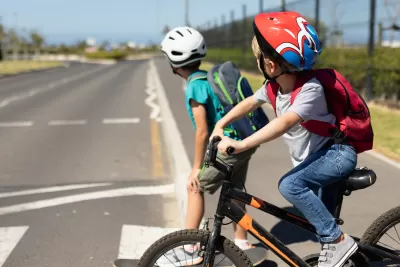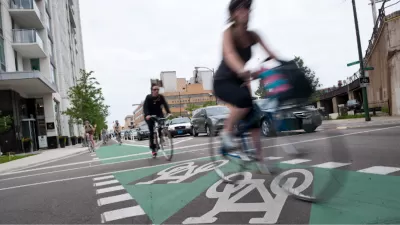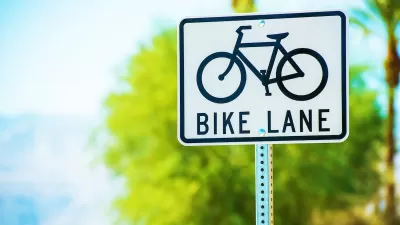Parents and students around the country are organizing into ‘bike buses’ to keep children safe while biking to and from school.

A new movement dubbed by some as “kidical mass” is using power in numbers to create safe, active bike-to-school groups, reports John Surico in The New York Times.
Also known as a ‘bike bus,’ the concept involves groups of adults and children organizing to ride bikes to and from local schools. Bike buses are organized by volunteer parents and advocates, with groups organizing to schedule shifts, collect safety gear, and spread the word to neighbors.
According to Surico, “Research shows that children arrive at school more engaged when they walk or cycle there.” In 1969, close to half of U.S. schoolchildren walked to school. Today, that number is around 13 percent, and many U.S. roads are too dangerous for children to safely get to school on their own.
Surico points out that “For now, bike bus routes tend to exist in whiter and wealthier neighborhoods. When a reporter joined the Bergen route, no children participated for its first mile through Crown Heights, where cycling infrastructure is less accessible.” But parents and other volunteers involved hope that the movement will draw attention to the need for safer pedestrian and bike infrastructure near schools so children can safely use a variety of transportation modes.
FULL STORY: Make Way for the Bike Bus

Alabama: Trump Terminates Settlements for Black Communities Harmed By Raw Sewage
Trump deemed the landmark civil rights agreement “illegal DEI and environmental justice policy.”

Planetizen Federal Action Tracker
A weekly monitor of how Trump’s orders and actions are impacting planners and planning in America.

The 120 Year Old Tiny Home Villages That Sheltered San Francisco’s Earthquake Refugees
More than a century ago, San Francisco mobilized to house thousands of residents displaced by the 1906 earthquake. Could their strategy offer a model for the present?

LA’s Tree Emergency Goes Beyond Vandalism
After a vandal destroyed dozens of downtown LA trees, Mayor Karen Bass vowed to replace them. Days later, she slashed the city’s tree budget.

Sacramento Leads Nation With Bus-Mounted Bike Lane Enforcement Cameras
The city is the first to use its bus-mounted traffic enforcement system to cite drivers who park or drive in bike lanes.

Seattle Voters Approve Social Housing Referendum
Voters approved a corporate tax to fund the city’s housing authority despite an opposition campaign funded by Amazon and Microsoft.
Urban Design for Planners 1: Software Tools
This six-course series explores essential urban design concepts using open source software and equips planners with the tools they need to participate fully in the urban design process.
Planning for Universal Design
Learn the tools for implementing Universal Design in planning regulations.
Ada County Highway District
Clanton & Associates, Inc.
Jessamine County Fiscal Court
Institute for Housing and Urban Development Studies (IHS)
City of Grandview
Harvard GSD Executive Education
Toledo-Lucas County Plan Commissions
Salt Lake City
NYU Wagner Graduate School of Public Service





























